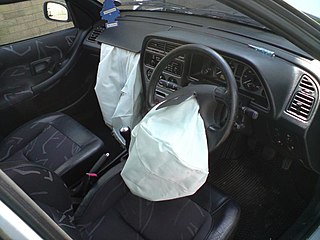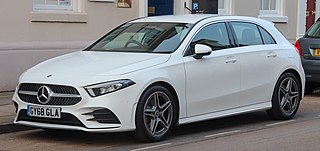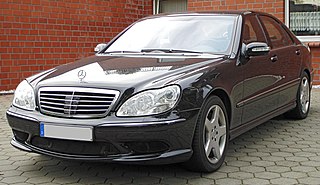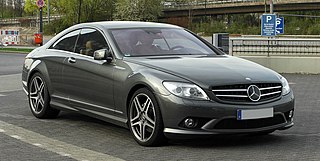
The Mercedes-Benz ESF 2009 Experimental Safety Vehicle is a safety research vehicle based on the S400 Hybrid, unveiled in 2009. [1]

The Mercedes-Benz ESF 2009 Experimental Safety Vehicle is a safety research vehicle based on the S400 Hybrid, unveiled in 2009. [1]
The vehicle was unveiled at the Enhanced Safety of Vehicles (ESV) Conference in Stuttgart. [3]

An airbag is a vehicle occupant-restraint system using a bag designed to inflate in milliseconds during a collision and then deflate afterwards. It consists of an airbag cushion, a flexible fabric bag, an inflation module, and an impact sensor. The purpose of the airbag is to provide a vehicle occupant with soft cushioning and restraint during a collision. It can reduce injuries between the flailing occupant and the vehicle's interior.

The Mercedes-Benz S-Class, formerly known as Sonderklasse, is a series of full-sized luxury sedans and coupés produced by the German automaker Mercedes-Benz. The S-Class is the designation for top-of-the-line Mercedes-Benz models and was officially introduced in 1972 with the W116, and has remained in use ever since. The S-Class is the flagship vehicle for Mercedes-Benz, being positioned above the other Mercedes-Benz models.

The Mercedes-Benz GLK-Class is a Compact luxury crossover SUV produced from 2008 to 2015, debuting at the 2008 Beijing Auto Show. The name GLK is an acronym for Geländewagen Luxus Kompaktklasse, taking its name from the larger Mercedes-Benz GL-Class, which in turn was named after the G-Wagen or Geländewagen. Thus, the GL is the luxury-oriented version of the G, and GLK is the compact version of the GL.

The Mercedes-Benz A-Class is a subcompact car manufactured by Mercedes-Benz and marketed across fourth generations as a front-engine, front-wheel drive, five-passenger, five-door hatchback, with a three-door hatchback offered for the second generation.

The Mercedes-Benz W211 is the third generation Mercedes-Benz E-Class made from 2001 to 2009 in sedan/saloon and station wagon/estate configurations – replacing the W210 E-Class models and superseded by the Mercedes-Benz W212 in 2009.

The Mercedes-Benz W220 was a range of flagship sedans which, as the fourth generation Mercedes-Benz S-Class, replaced the W140 S-Class after model year 1998 — with long and short wheelbase versions, performance and luxury options; available four-wheel drive; and a range of diesel as well as gas/petrol V6, V8, and V12 engines. Compared to its predecessor, the W220 had somewhat smaller exterior dimensions but offered greater interior volume, particularly in the long-wheelbase versions, and slightly less cargo volume.

Active Body Control, or ABC, is the Mercedes-Benz brand name used to describe electronically controlled hydropneumatic suspension.

The Mercedes-Benz W221 is a chassis code of the fifth generation S-Class, produced from August 2005 until June 2013. The W221 S-Class was unveiled at the 2005 Frankfurt Motor Show as the successor of the Mercedes-Benz S-Class (W220) and the predecessor of the Mercedes-Benz S-Class (W222).

The W212 and S212 Mercedes-Benz E-Class series is the fourth generation of the E-Class range of executive cars which was produced by Mercedes-Benz between 2009 and 2016 as the successor to the W211 E-Class. The body styles of the range are either four-door sedan/saloon (W212) or a five-door estate/wagon (S212). Coupé and convertible models of the E-Class of the same generation are W204 C-Class based and known as the C207 and A207, replacing the CLK-Class coupé and cabriolet. A high-performance E 63 AMG version of the W212 and S212 were available as well since 2009. In 2013, a facelift was introduced for the E-Class range, featuring significant styling changes, fuel economy improvements and updated safety features.

The Mercedes-Benz C216 is the last generation for the grand tourer with name Mercedes-Benz CL-Class, produced from 2006 to 2014. It replaced the C215 platform, and was replaced in 2014 by the C217 S-Class Coupe.
Brake assist or emergency brake assist (EBA) is a term for an automobile braking technology that increases braking pressure in an emergency. The first application was developed jointly by Daimler-Benz and TRW/LucasVarity. Research conducted in 1992 at the Mercedes-Benz driving simulator in Berlin revealed that more than 90% of drivers fail to brake with enough force when faced with an emergency.

Adaptive cruise control (ACC) is a type of advanced driver-assistance system for road vehicles that automatically adjusts the vehicle speed to maintain a safe distance from vehicles ahead. As of 2019, it is also called by 20 unique names that describe that basic functionality. This is also known as Dynamic cruise control.

The Mercedes-Benz Vito is a mid-sized light commercial vehicle (LCV) produced by Mercedes-Benz, available as a panel van, chassis cab, or multi-purpose vehicle (MPV), carrying cargo or up to eight passengers. In the Mercedes-Benz van lineup, it is positioned between the larger Sprinter and the smaller Citan.

A collision avoidance system (CAS), also known as a pre-crash system, forward collision warning system (FCW), or collision mitigation system, is an advanced driver-assistance system designed to prevent or reduce the severity of a collision. In its basic form, a forward collision warning system monitors a vehicle's speed, the speed of the vehicle in front of it, and the distance between the vehicles, so that it can provide a warning to the driver if the vehicles get too close, potentially helping to avoid a crash. Various technologies and sensors that are used include radar (all-weather) and sometimes laser (LIDAR) and cameras to detect an imminent crash. GPS sensors can detect fixed dangers such as approaching stop signs through a location database. Pedestrian detection can also be a feature of these types of systems.
Mercedes-Benz, commonly referred to simply as Mercedes and occasionally as Benz, is a German luxury and commercial vehicle brand that was founded in 1926. Mercedes-Benz AG is based in Stuttgart, Baden-Württemberg, Germany. Mercedes-Benz AG manufactures luxury vehicles and light commercial vehicles, all branded under the Mercedes-Benz name. From November 2019 onwards, the production of Mercedes-Benz-branded heavy commercial vehicles has been managed by Daimler Truck, which separated from the Mercedes-Benz Group to form an independent entity at the end of 2021.

The Mercedes-Benz BlueZERO concept is Mercedes' attempt at the alternative fuel vehicle movement. The BlueZERO is a flexible concept that has the ability to accommodate the three different types of future alternative fuels: electric, hybrid, and hydrogen fueled. It was first introduced at the 2009 Detroit Auto Show which took place January 11–25. It features a single vehicle architecture that accommodates three models with different electric power-train configurations, each of which are fully developed and ready for testing. The Mercedes-Benz BlueZERO electric drive system gives each model the same performance specifications for acceleration and top speed. The Mercedes-Benz BlueZERO electric drive modular design accelerates from 0 to 100 km/h (62.5 mph) in under 11 seconds, and the top speed is electronically governed to 150 km/h (93 mph) in the interests of optimal range and energy efficiency. Peak torque is 320 N⋅m (236 lb⋅ft) and as with all EVs, maximum torque is available from zero rpm.

The Mercedes-Benz Citan is a panel van and leisure activity vehicle introduced as a badge-engineered variant of the Renault Kangoo in 2012 and marketed by Mercedes-Benz as the successor to the Vaneo compact MPV. In the Mercedes-Benz van lineup, the Citan is the smallest model offered, alongside the mid-size Vito and large Sprinter.

The Mercedes-Benz CLA is a series of luxury subcompact executive cars manufactured by Mercedes-Benz since 2013. The first generation was a four-door sedan based on the platform of the W176 A-Class and W246 B-Class compact cars, marketed as a four-door coupé. In 2015, Mercedes-Benz expanded the CLA family to include a station wagon configuration which it markets as a Shooting Brake. As the V177 A-Class sedan took its place as the budget-conscious sedan, the second generation got longer and wider than the W205 C-Class.

The Mercedes-Benz W222 is the sixth generation of the Mercedes Benz S-Class produced from 2013 to 2020, serving as the successor to the W221 S-Class and predecessor to the W223 S-Class. The W222 was designed in 2009 by Korean designer Il-hun Yoon, who drew inspiration from the Mercedes-Benz F700 concept car. The exterior design was developed by a team under the direction of the Slovenian car designer Robert Lešnik. The W222 has a similar design theme to the C-Class (W205) and E-Class (W213).

W246 is the internal designation for the second generation Mercedes-Benz B-Class, which is a range of 5-door hatchbacks produced by German luxury manufacturer Daimler AG under the Mercedes-Benz brand from late 2011 to late 2018. Introduced at the 2011 International Motor Show Germany as a subcompact executive car, model years for the W246 started at 2012 and ranged to 2018. European models went on sale in November 2011. Japanese and Australian models went on sale in April 2012, and Canadian models in late 2012 as the 2013 model year. They were assembled at Rastatt, Germany, and from 2011 at Kecskemét, Hungary. By summer 2013, over 230,000 second generation B-Class cars had been delivered.
{{cite web}}: CS1 maint: numeric names: authors list (link)